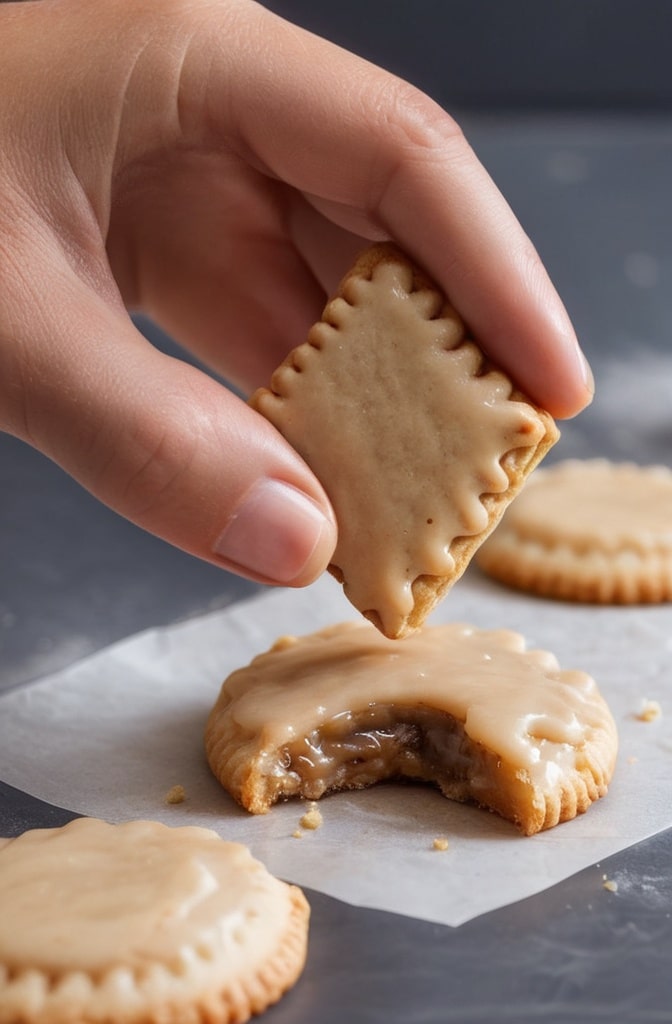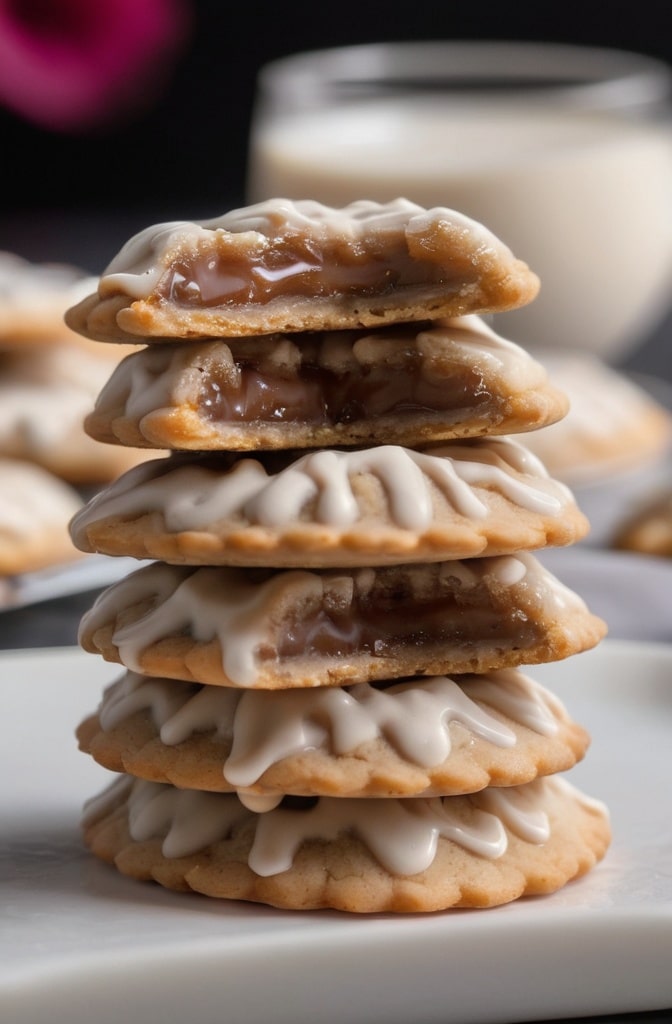The smell of toasted Pop Tarts on weekday mornings before school—there’s nostalgia baked into those memories. I still remember the satisfying crack of biting into that crisp pastry exterior, revealing the sweet, gooey filling within. Those childhood breakfast treats have inspired something extraordinary in my kitchen: Brown Sugar Pop Tart Cookies.
What if I told ya that the iconic brown sugar cinnamon Pop Tart could be reimagined as a cookie? These treats capture everything magical about the original—the buttery, flaky exterior, that cinnamon-speckled brown sugar filling, and yes, even that signature icing drizzle. But they’re even better because they’re homemade with quality ingredients and customizable to your exact preferences.
Ingredients & Substitutions
For the Cookie Dough:
- 2½ cups all-purpose flour
- 1 tablespoon cornstarch (creates that tender, shortbread-like texture)
- ½ teaspoon salt
- 1 cup unsalted butter, softened (room temperature is crucial here)
- ¾ cup granulated sugar
- 1 large egg
- 2 teaspoons vanilla extract
- ¼ teaspoon almond extract (optional, but adds depth)
For the Brown Sugar Filling:
- 1 cup packed dark brown sugar (light works too, but dark provides richer flavor)
- 2½ tablespoons all-purpose flour
- 1½ tablespoons ground cinnamon
- ¼ teaspoon salt
- 3 tablespoons unsalted butter, melted
- 1 teaspoon vanilla extract
For the Icing:
- 1 cup powdered sugar
- 2-3 tablespoons milk
- ½ teaspoon vanilla extract
- Pinch of salt
If your pantry’s lookin’ a bit different than the ingredient list, don’t worry. For dairy-free versions, coconut oil can replace butter in the dough (use slightly less), though the texture will be somewhat different. Plant-based butter alternatives work well too. Gluten-free bakers can substitute a 1:1 all-purpose gluten-free flour blend, but add ¼ teaspoon xanthan gum if your blend doesn’t already include it.
The dark brown sugar creates that authentic Pop Tart filling flavor, but if you’ve only got light brown sugar, add a teaspoon of molasses to mimic the deeper caramel notes. In a pinch, coconut sugar works as a substitute with a slightly different but equally delicious flavor profile.
Step-by-Step Instructions

Preparing the Cookie Dough
- Whisk the flour, cornstarch, and salt together in a medium bowl. This even distribution prevents pockets of salt or cornstarch that might affect texture. Set aside.
- In a large bowl, cream the softened butter and granulated sugar until light and fluffy—about 3-4 minutes. Don’t rush this step! The air incorporated here is essential for that perfect cookie texture. The mixture should change from yellow to almost white.
- Add the egg and extracts to the butter mixture, beating until fully incorporated. Scrape down the sides of your bowl occasionally; those unmixed portions at the edge can mess with your final texture.
Gradually add the flour mixture to the wet ingredients, mixing on low speed just until combined. Overmixing will activate the gluten in the flour and make your cookies tough insted of tender. The dough should be soft but not sticky—kinda like play-dough.
- Divide the dough in half, form each half into a rectangle, and wrap in plastic wrap. Chill for at least 1 hour or up to 2 days. This resting period allows the flour to fully hydrate and makes the dough easier to roll out.
Creating the Brown Sugar Filling
- While the dough chills, combine brown sugar, flour, cinnamon, and salt in a medium bowl. The flour helps prevent the filling from liquefying during baking—a common mistake that leads to leaky cookies.
- Pour in the melted butter and vanilla, then stir until the mixture resembles wet sand. Set aside to cool completely. If it seems too wet, add another teaspoon of flour; if too dry, a touch more melted butter.
Assembling and Baking the Cookies
- Preheat your oven to 350°F (175°C) and line baking sheets with parchment paper. Working with one portion of dough at a time (keeping the other refrigerated), roll it out on a lightly floured surface to about ⅛-inch thickness.
- Using a ruler and pizza cutter or knife, cut the dough into 3×4-inch rectangles. Don’t stress if they’re not perfect—handmade charm is part of the appeal! Re-roll scraps as needed, but try to handle the dough as little as possible to keep it tender.
- Transfer half of the rectangles to your prepared baking sheets, spacing them about 1 inch apart. These will be your bottom pieces. If the dough becomes too soft to work with at any point, pop it back in the refrigerator for 10 minutes.
- Place about 1½ tablespoons of brown sugar filling in the center of each bottom rectangle, leaving a ½-inch border around the edges. Spread the filling carefully, maintaining that border—this prevents leakage during baking.
- Lightly brush the exposed edges with water or beaten egg to help seal the cookies. Place the remaining rectangles on top and gently press the edges with a fork to seal and create that classic Pop Tart crimped edge.
- Pierce the top of each cookie several times with a fork to allow steam to escape. This crucial step prevents your cookies from puffing up unevenly or bursting at the seams.
- Bake for 12-15 minutes, until the edges are just beginning to turn golden. These cookies shouldn’t brown too much—remember, we’re mimicking Pop Tarts, which are relatively pale. Let cool on the baking sheets for 5 minutes before transferring to a wire rack to cool completely.
Cooking Techniques & Science
The success of these cookies lies in the delicate balance between a shortbread-like exterior and that signature brown sugar filling. The addition of cornstarch to the dough weakens the protein structure that forms when flour gets wet, resulting in that tender, melt-in-your-mouth texture that makes these cookies so irresistible.
Temperature control is critical throughout this recipe. Room temperature butter creams properly with sugar, creating tiny air pockets that expand during baking for the perfect texture. Conversely, chilled dough maintains its shape during rolling and cutting, preventing the dreaded spread that can ruin the rectangular Pop Tart aesthetic.
The egg wash or water sealing technique borrows from traditional pastry-making. It creates a protein bond between the top and bottom layers—essentially gluing them together during baking. The fork crimping not only decoratively seals the edges but creates a compressed dough area that bakes more firmly than the center, providing structural integrity.
Ever wonder why the filling doesn’t just melt and run out? That’s where the flour in the filling comes in. It absorbs moisture and creates a paste-like consistency that stays put during baking. The melted butter coats the sugar crystals, allowing them to heat without immediately dissolving, preserving that slightly grainy texture authentic to the original Pop Tart filling.
For those who prefer a softer cookie reminiscent of the actual Pop Tart texture, try substituting part of the all-purpose flour with cake flour, which has less protein. On the flip side, if you’re lookin’ for a crunchier exterior, a slightly longer bake time (1-2 minutes) will achieve that.
Icing and Finishing Touches
- Once the cookies are completely cool, prepare the icing by whisking together powdered sugar, milk, vanilla extract, and salt until smooth. The icing should be thick but pourable—like honey. If it’s too thick, add milk a few drops at a time; if too thin, add more powdered sugar.
- Drizzle or spread the icing over each cookie. For that classic Pop Tart look, cover the entire top surface, leaving just a tiny border visible. Work quickly as the icing will begin to set.
- For colorful variations, divide the icing and add food coloring. Sprinkles, while not traditional for the brown sugar cinnamon variety, can add a festive touch for special occasions. Some bakers like adding a dash of cinnamon to the icing for extra flavor depth.
- Allow the icing to set completely (about 1 hour) before stacking or storing the cookies. This patient waiting prevents smudged icing and preserves that picture-perfect finish.
Serving & Pairing Suggestions
These nostalgic treats shine brightest when served slightly warm, mimicking that just-toasted Pop Tart experience. Ten seconds in the microwave will do the trick! Pair them with a cold glass of milk for the ultimate childhood throwback.
For an elevated dessert experience, serve a warm Brown Sugar Pop Tart Cookie alongside a scoop of vanilla bean ice cream. The contrast between warm cookie and cold, creamy ice cream creates a sensory delight that’ll have guests asking for seconds.
Coffee enthusiasts will appreciate these cookies alongside a cappuccino or latte—the cinnamon and brown sugar notes complement the espresso beautifully. For tea drinkers, a robust chai or gentle earl grey makes an excellent companion.
These cookies make stunning gifts, too. Stack them in cellophane bags tied with ribbon, or arrange them in a vintage tin for holiday giving. They’re sturdy enough to ship well, making them perfect for care packages or distant loved ones.
For brunches or breakfast gatherings, arrange these cookies on a platter interspersed with fresh berries and mint leaves. The bright colors and fresh flavors balance the cookies’ sweetness while creating an eye-catching presentation.
Storage and Make-Ahead Tips
These cookies maintain their texture and flavor for up to 5 days when stored in an airtight container at room temperature. Place parchment paper between layers to protect the icing.

The unbaked dough freezes beautifully for up to 3 months. Cut and fill the cookies, then freeze them on a baking sheet before transferring to freezer bags. Bake directly from frozen, just adding 2-3 minutes to the baking time—perfect for emergency dessert situations!
Baked, unfrosted cookies can also be frozen for up to 2 months. Thaw at room temperature and add fresh icing before serving for that just-baked quality.
Variations to Explore
While the brown sugar cinnamon flavor is iconic, this recipe template opens the door to countless variations inspired by other Pop Tart flavors:
- Strawberry: Replace the brown sugar filling with strawberry preserves mixed with a tablespoon of cornstarch. Add a drop of red food coloring to the icing.
- S’mores: Add crushed graham crackers to the dough, use a chocolate ganache filling, and top with toasted mini marshmallows instead of icing.
- Chocolate Fudge: Add 3 tablespoons of cocoa powder to the dough and use a fudge filling made from melted chocolate chips, condensed milk, and a pinch of salt.
- Savory Version: For an unexpected appetizer, omit the sugar in the dough, fill with pesto and goat cheese, and skip the icing entirely.
Conclusion
These Brown Sugar Pop Tart Cookies represent the perfect marriage between nostalgic childhood treats and sophisticated homemade baking. By controlling the quality of ingredients and fine-tuning the process, we’ve elevated a commercial product into something truly special—worthy of both everyday indulgence and special occasions.
The beauty of these cookies lies in their versatility. They’re impressive enough for a dessert table yet approachable enough for a casual snack. They connect generations through shared food memories while creating new traditions.
Master the basic technique, then let your imagination run wild with variations. Whether you’re recreating favorite Pop Tart flavors or inventing combinations never found in the grocery aisle, these cookies provide an exceptional canvas for culinary creativity.
Remember the key takeaways: temperature control (both for ingredients and baking), proper sealing techniques, and patience during each stage of the process. Get these fundamentals right, and you’ll be rewarded with perfect Brown Sugar Pop Tart Cookies every time.
FAQs
Why did my filling leak out during baking?
The most common cause is inadequate sealing around the edges. Make sure to leave a wider border around the filling (at least ½-inch) and press firmly with the fork tines to create a proper seal. Chilling the assembled cookies for 15 minutes before baking can also help prevent leakage by firming up the dough.
Can I make these cookies smaller for a bite-sized version?
Absolutely! You can create mini versions by cutting 2×2-inch squares instead. Reduce the filling to about ½ tablespoon per cookie and decrease the baking time by 2-3 minutes. These make adorable additions to dessert platters or lunchboxes.
How do I prevent my cookies from puffing up too much in the center?
Don’t skip those fork pricks on top! They serve an important purpose—allowing steam to escape during baking. If you’re still experiencing puffing, try chilling the assembled cookies for 30 minutes before baking and make a few more ventilation holes.
My icing hardens too quickly while I’m working. What can I do?
Keep the icing bowl over another bowl of warm (not hot) water to maintain a workable consistency longer. Alternatively, work with smaller batches of icing at a time, keeping the remainder covered with plastic wrap directly on the surface to prevent drying out.
Can I make the filling ahead of time?
Yes! The brown sugar filling can be made up to 3 days in advance and stored in an airtight container in the refrigerator. Bring it to room temperature before using so it spreads easily without tearing the dough.

